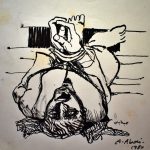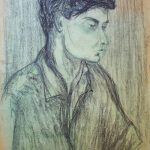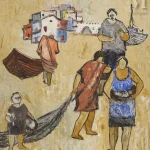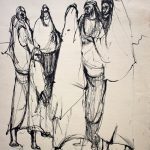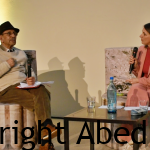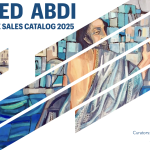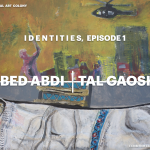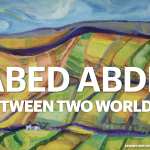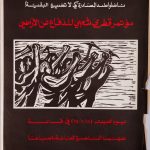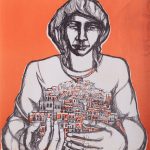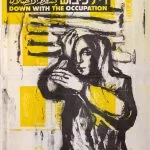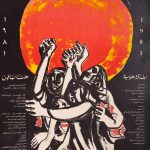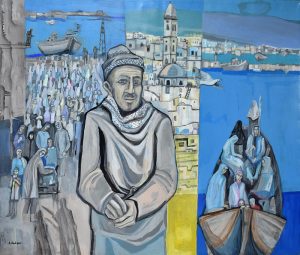
Jerusalem Quarterly Issue 80 –
Review of Exhibition: “1948,” Haifa City Museum, 4 December 2018–28 April 2019.
On Ben Gurion Street in Haifa’s Germany Colony, banners flutter in the wind. Emblazoned on them is simply a date: 1948. The Haifa City Museum – an official municipal museum – was showing a major exhibit that offered us both hope and contradiction. The exhibit ran for over six months in the museum, located in two old houses, one a late nineteenth century German Templar building and the other a former school.
The first floor assembled works from the generation of 1948, including cartoons from Hebrew newspapers, sketches and portraits of heroic (and sometimes humorous) soldiers of the Haganah and of the mourning of Jewish families who lost loved ones even amid triumph. The only Arab artist on the first floor was Abed Abdi, who was born in 1942 in Haifa but was forced out with his family to Lebanon in 1948, returning when he was ten years old under a limited family reunification scheme. His oil painting on exhibit, Refugees (1957), is a poignant, indeed chilling, portrait of Palestinian women and children looking at two men and a child lying dead in the foreground. Much of Abdi’s work accompanied articles in al-Ittihad, the Arabic-language Israeli Communist newspaper of that era, and were pioneering in depicting the Nakba and its multiple tragedies. In his essay in the exhibit’s catalogue, Dr. Housni Alkhateeb Shehada notes that many of Abdi’s works accompanied a series of newspaper articles by Salman Natur. The title of the series was, tellingly, “We Have Not Forgotten.”
The uneasy contradictions we felt in the exhibit were not only in its visual presentation, but also reflected in the statements by the co-curators of the exhibit. Maged Khamra expressed his doubts:
From a higher perspective, as co-curator of the exhibition “1948,” I would like to discuss the dilemma facing us in our attempt to present, in one museum space, conflicts and confrontations between identities and memories using historical materials and artworks. This approach may create a false sense of reconciliation between the poles presented in the show, resulting from a curatorial gesture that seeks to balance – consciously or not – between the winning and losing side. The exhibition creates an illusory space.
Co-curator Inbar Dror Lax, on the other hand, valorized the exhibit’s balance: “The exhibition 1948 seeks to avoid reducing the 1948 war to one meta-narrative or the other, enabling the City Museum to be an entity that is multi-cultural and multi-generational, containing multiple narratives.” While it is hard to contest that “the dramatic change undergone by Haifan society in the 1948 war can still be felt in the city’s urban spaces, its buildings, residents and cultural-historical climate,” Dror Lax falls back on the weary paradigm that the exhibit creates a “human mosaic that presents the various aspects of one fateful moment.” This sits oddly with the acknowledgement in the foreword that “by 21 April 1948 about half of [Haifa’s] Arab residents had left. As the battles raged on, almost all of those remaining left as well.”
As we wandered through the exhibit for a second time, the artworks of third-generation Palestinian artists spoke to us most directly. In Nardeen Srouji’s (born in Nazareth, 1980) Buqjah 1 (Bundle 1), the protruding shapes of objects inside a pristine white ceramic bundle remind us of the few possessions Palestinian refugees took into exile in 1948. We stood for quite a while in front of Manal Mahamid’s layered tower of concrete, entitled The Year 1948, guessing at what we could barely see – houses and perhaps their inhabitants buried under an inflexible medium central to Israel’s relentless building over Palestinian ruins. Mahamid (born in Mu‘awiya, 1976) told us that she has not exhibited in institutional Israeli spaces for a number of years: this work is on loan from a gallery in Umm al-Fahm.
In a disturbing self-portrait, Michael Halak (born in Fassuta, 1975) paints himself in a highly realistic style in the uniform and helmet of an Israeli army recruit. The world of these works is at a great distance from any social “mosaic”; instead, we find alienation and exclusion or, in pieces less inflected with a sense of crisis and contradiction, recoveries of the Palestinian past, such as Fatma Shanan’s (born in Julis, 1986) video Carpets on a Roof, where she enlisted friends and neighbors to lay out carpets – objects that are closely tied to home and family – in various patterns on a rooftop in her village.
Even in these exhibits that do address the “wound of 1948” in different ways, art is constrained by politics. In a thought-provoking work by actor Lamis Nammar, side-by-side videos show her wandering through Berlin’s Holocaust memorial and Wadi Nisnas, the Arab neighborhood in Haifa that was most devastated by war and exile. She had wanted to call it Nakba, but was told she could not use the word for fear of legal action. Instead she called it Untitled by Law.


